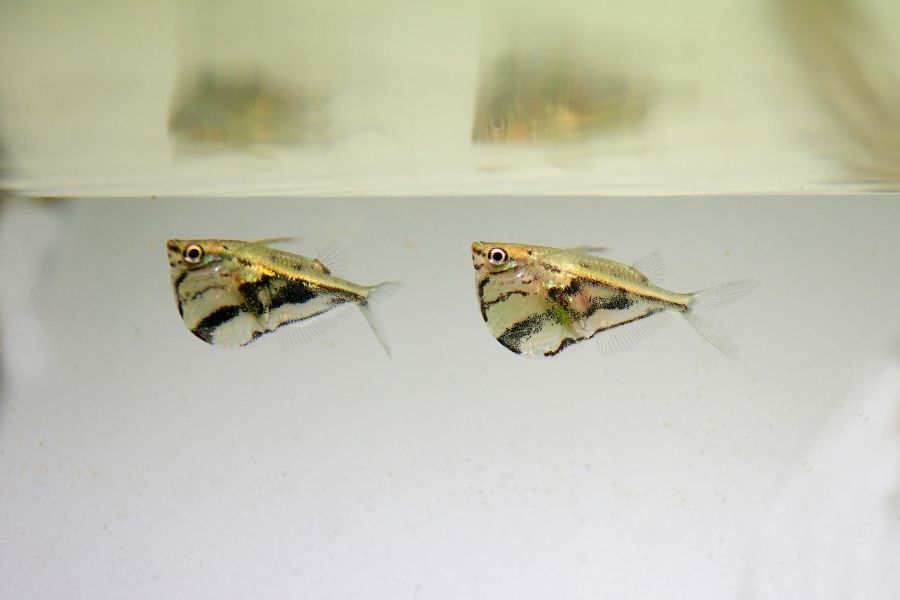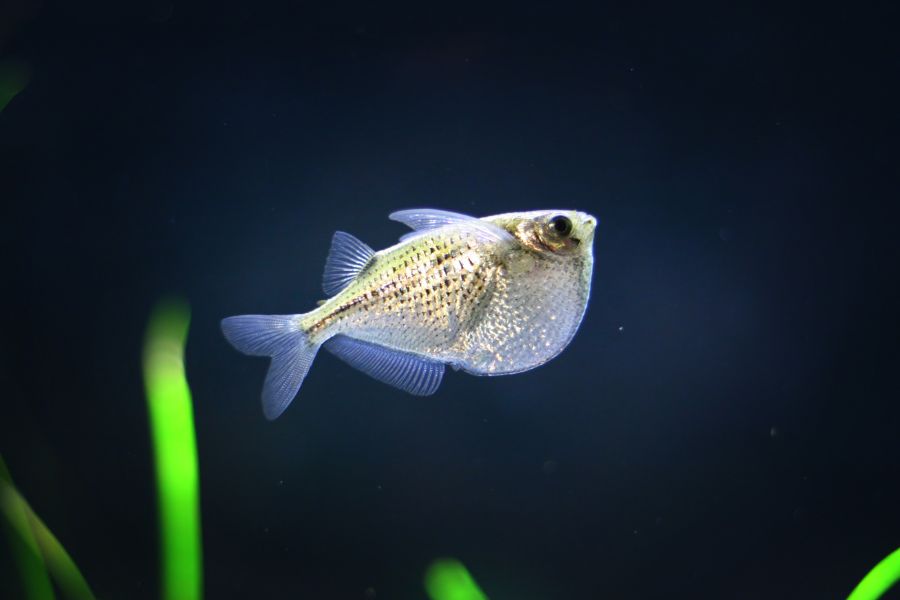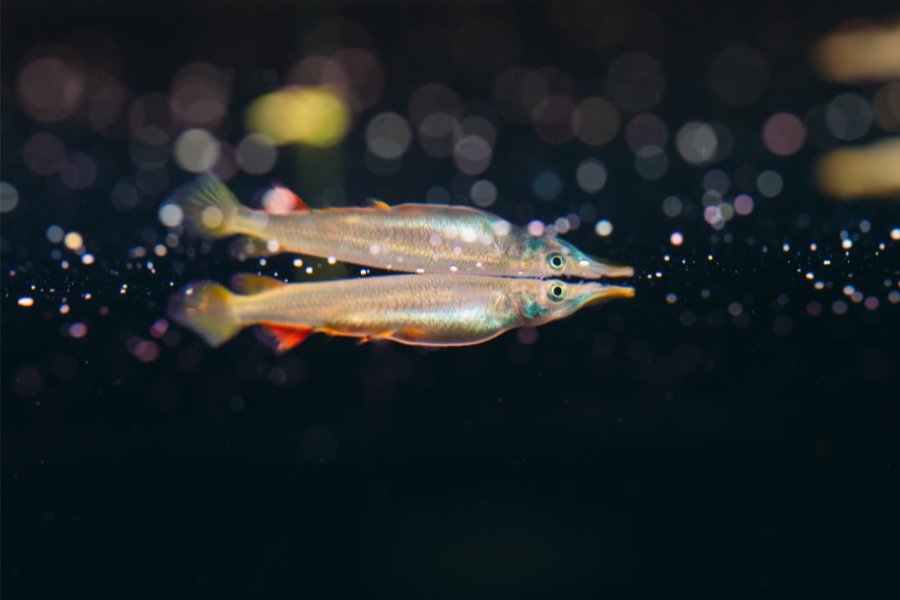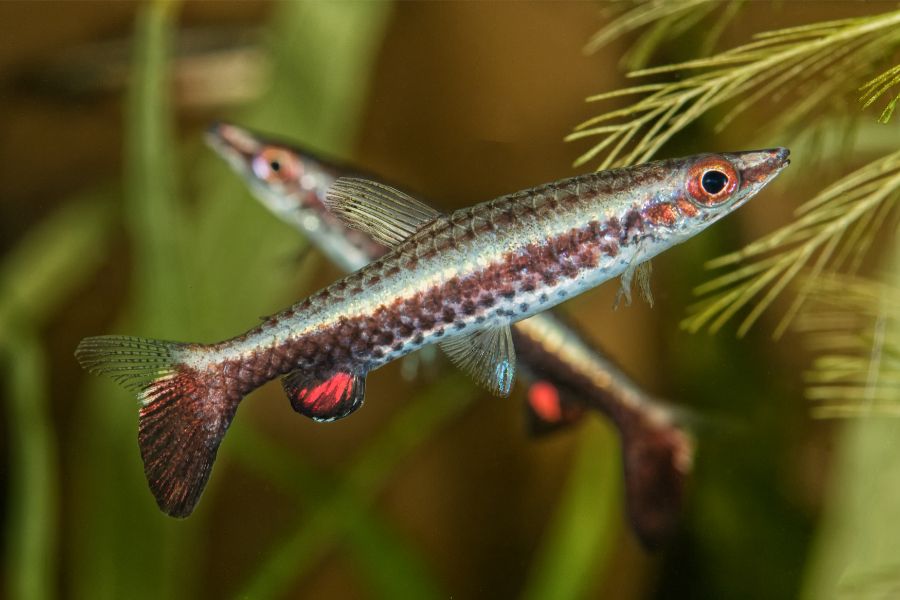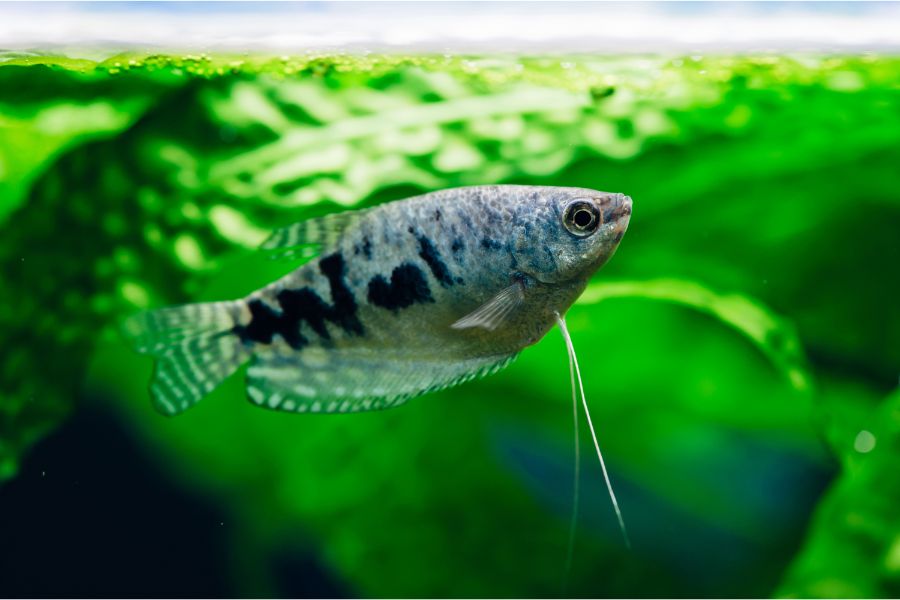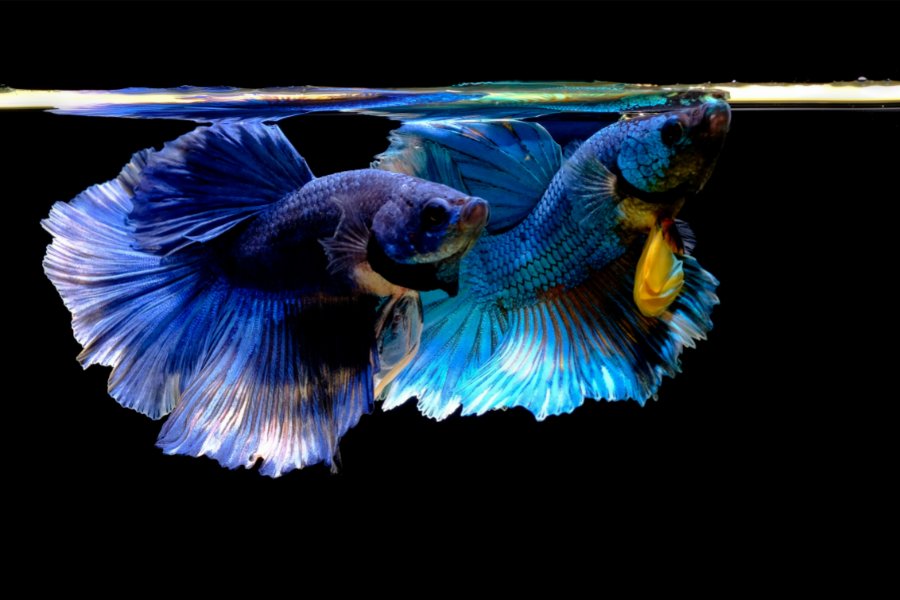Are you looking to balance your aquarium and improve its aesthetics? Consider introducing some top-dwelling fish.
As the name suggests, top-dwelling fish or surface dwellers prefer cruising around the top level of the tank.
They usually have upturned (upward-facing) mouths designed for surface feeding. Also, their fins slung far back, allowing them to swim under the water’s surface without causing disturbances.
But with so many fish species to choose from, it can prove difficult to decide which species you will introduce to your aquarium. But don’t worry! We are here to help.
This comprehensive guide includes a variety of top-dwelling fish species, each with its distinct characteristics and requirements to help you identify the perfect fish.
Whether you are a novice or an experienced aquarist, these top surface dwellers will make a great addition to your aquarium.
11 Best Top-Dwelling Fish
1. Marbled Hatchet Fish
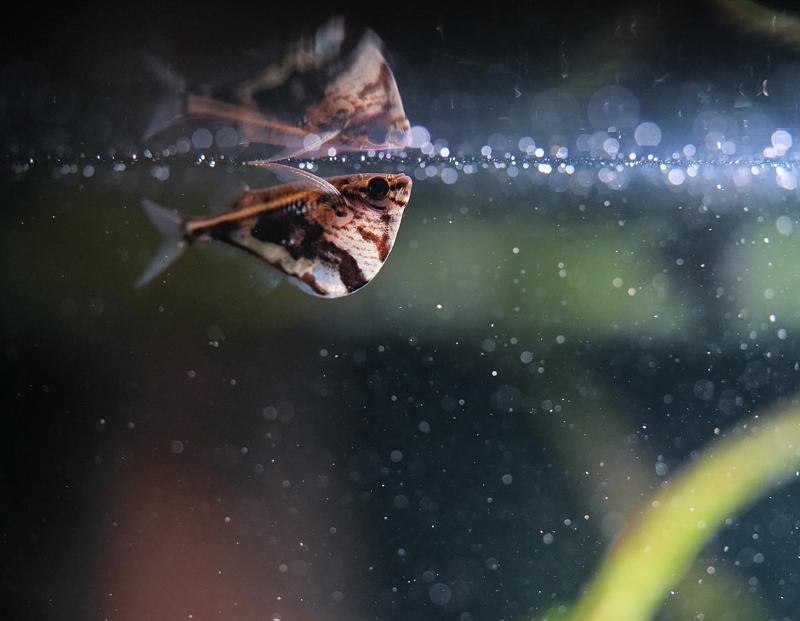
- Scientific Name: Carnegiela strigata
- Size: 1–2 inches
- Water Parameters: pH- 5.5 to 6.5, Temperature – 74 to 82°F
- Tank Size: Minimum of 15 gallons
- Compatible With: Can co-exist with many fish species that have similar water conditions
The Marbled Hatchetfish is one of the most popular hatchetfish in the pet industry. Native to South America, these unique fish love cruising at the top of the tank.
They are active swimmers and love tanks with plenty of space so they can dart and roam freely. But many hobbyists recommend introducing floating aquarium plants to offer the fish cover when frightened or want to sleep.
These fish are peaceful and social, which makes them great for community tanks. However, they don’t love sharing the top level of the tank with any other fish. Avoid keeping them with surface dwellers, like bettas and other hatchetfish species.
One downside to these tiny fish is their short lifespan–they live for a maximum of two years. You might also want to put a lid on the tanks since the fish are fond of jumping.
2. Silver Hatchetfish
- Scientific Name: Gasteropelecus sternicla
- Size: 3–4 inches
- Water Parameters: pH–0 to 7.5, Temperature–72 to 82°F
- Tank Size: Minimum of 30 gallons
- Compatible With: Peaceful and similar-sized fish, like Corydoras catfish and tetras
Silver Hatchetfish or Common Hatchetfish is a highly sought-after fish species by aquarists. Like its cousin -Marble Hatchet, this fish boasts a distinct body shape and radiant silver coloration. They like hanging out near the surface of the water, adding movement and activity at the top level.
Like most top-dwelling fish, they are great jumpers and can leap several feet out of the tank. What’s more, they can target jump through holes in the aquarium. Because of this, a tight-fitting lid is necessary.
Another thing, this fish species is prone to gluttony in captivity. They often dash toward and gobble up any surface-floating foods. As such, they can compete with tank companions during feeding time. The best way to reduce competition is to spread the food across the water surface to ensure uniform dispersal.
Because most Silver Hatchetfish are caught in the wild, ensure you buy healthy fish and treat them for diseases like ich.
3. Wrestling Halfbeak
- Scientific Name: Dermogenys pusillus
- Size: 5–2.5 inches
- Water Parameters: pH–0 to 8.0, Temperature–72 to 82°F
- Tank Size: Minimum of 10 gallons
- Compatible With: Peaceful fish species of similar size and same water conditions
Wrestling Halfbeaks inhabit the slow-flowing rivers, canals, and lakes of India, Laos, Vietnam, and Myanmar. It’s a small fish species that enjoys spending most of its time just under the water’s surface.
It stands out because of its distinctive half-beak month. Besides, it is a hardy and highly adaptable species, making it a suitable option for beginner and expert aquarists.
Generally, the Halfbeak fish are a peaceful and social species. However, they tend to be feisty, especially when introduced to a new environment. Including dense floating plants around the tank edges will prevent them from banging into the glass and damaging their delicate mouthparts.
4. Pygmy Hatchetfish
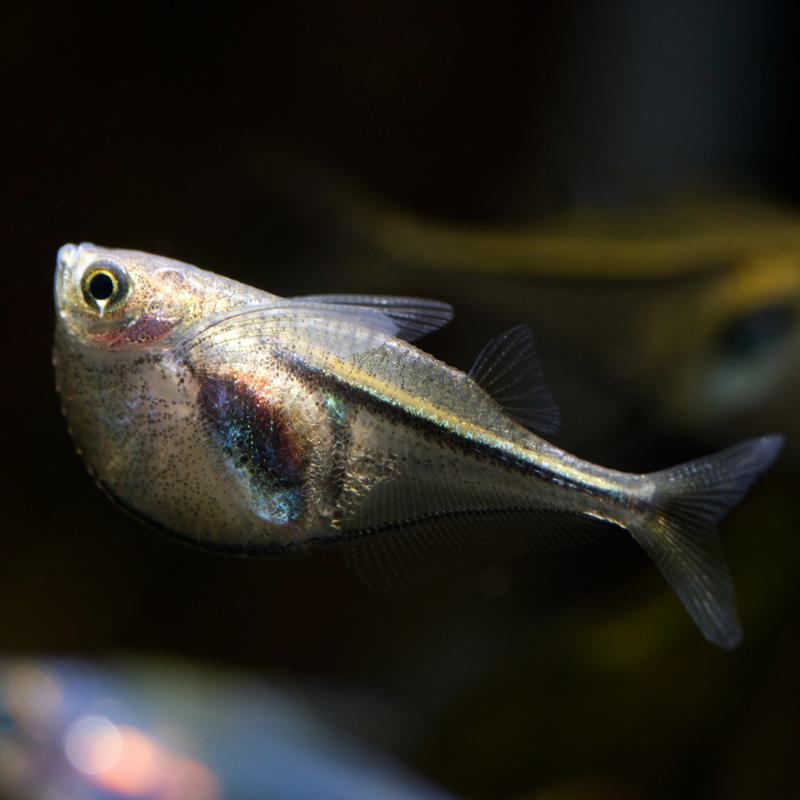
- Scientific Name: Carnigiella myersi
- Size: 1 inch
- Water Parameters: pH–0 to 7.0, Temperature–72 to 79°F
- Tank Size: Minimum of 10 gallons
- Compatible With: Peaceful fish species, like Loaches, dwarf Rasboras, dwarf Cichlids, and small tetras
The Pygmy Hatchetfish is another top dweller that makes a great addition to a community aquarium. It thrives in clear, warm, and slightly acidic water and prefers hanging at the top level. Sometimes, it propels itself above the water’s surfaces using its strong pectoral fins.
These fish are the smallest hatchet fish species, growing no more than 1 inch. And since they’re a schooling species, we recommend you keep them in groups of 6 to 8. They are also peaceful and avoid conflicts among themselves and fellow tank mates.
Pygmy Hatchetfish are best observed at night when they are active. Furthermore, they are hardy and easy to care for, as long as they receive proper care and nutrition.
5. Pencilfish
- Scientific Name: Nannostomus eques
- Size: 1–2 inches
- Water Parameters: pH 6.0–5, Temperature 72 – 82°F
- Tank Size: Minimum of 10 gallons
- Compatible With: Tetra, Rasboras, and Corydoras
Another top-dwelling fish worth checking out is the Pencilfish. They are a hardy and energetic fish species known for their unique, beautiful coloration and pencil-like bodies.
They also come with pointy snouts and swim horizontally (but the diptail pencil can swim diagonally at an angle of 45 °).
You can choose from several species of Pencilfish, including Brown-tail, Coral red, One-lined, Beckford’s, and Dwarf Pencilfish. But you should not keep them with over-active mates since they are shy.
Furthermore, they prefer densely planted tanks with several hiding places and enough room for swimming. While they eat flakes and other dry food, they relish treats of brine shrimp and blood warms.
6. Golden Wonder Panchax
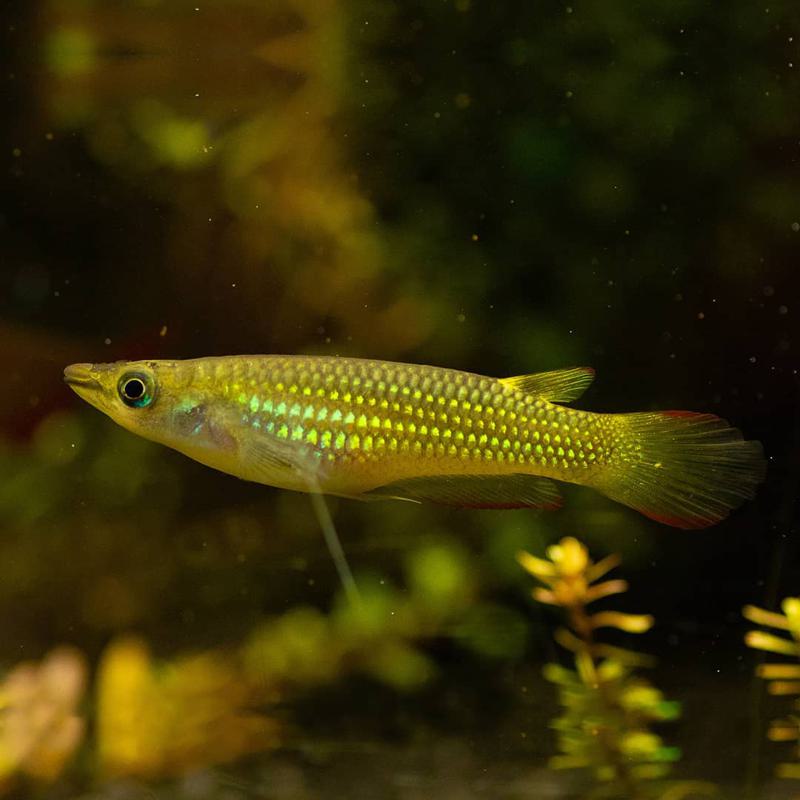
- Scientific Name: Aplocheilus lineatus
- Size: 3–5 inches
- Water Parameters: pH–5 to 7.5, Temperature–72 to 82°F
- Tank Size: Minimum of 30 gallons
- Compatible With: Dwarf cichlids, Banjo Catfish, Corydoras Catfish, and Banjo
The Golden Wonder Panchax is another impressive and radiant top-dweller every aquarist should have. It’s hardy, robust, and relatively peaceful.
They make great tank mates since they often avoid confrontations. But since they are predatory, avoid housing them with small fish that can fit in their wide mouths.
Like most top dwellers, Golden Wonder Panchax thrives in tanks with plenty of space and plants, including floating varieties. This holds, especially if you keep a group of both males and females. These fish are also excellent jumpers. So, ensure you cover your tank with a tight-fitting lid.
In the wild, these fish capture and eat insects and insect larvae from the water surface. But in captivity, you can feed them a variety of frozen meat-based foods. They will also enjoy a diet of brine shrimp, white mosquito larvae, and bloodworms.
7. Common Danios
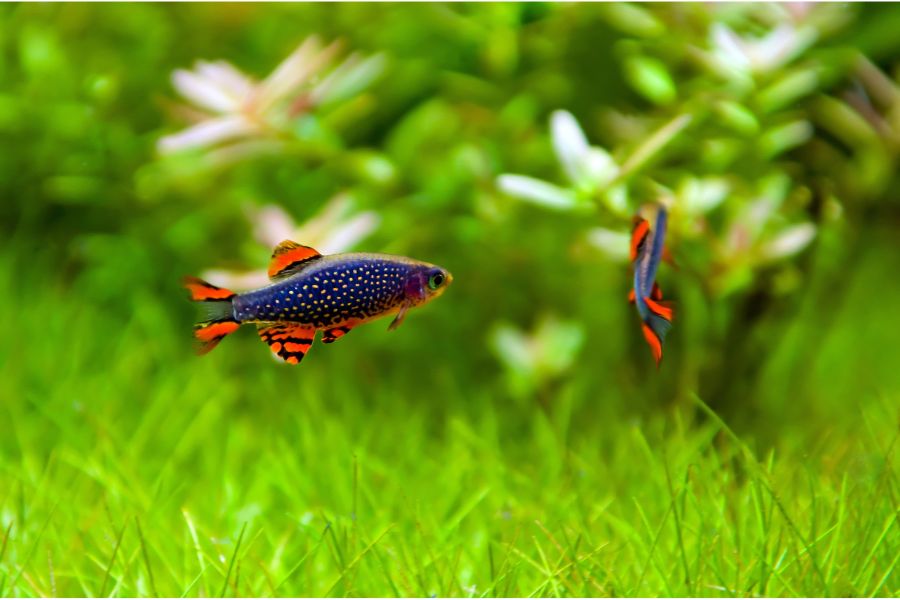
- Scientific Name: Danio spp
- Size: 5 to 2.5 inches
- Water Parameters: pH–0 to 7.5, Temperature–72 to 82°F
- Compatible With: Rubber-lip pleco, skirt tetras, swordtails, and tiny barbs
If you are looking for energetic surface dwellers, opt for common Danios, like Leopard Danios, Blue Danios, Zebra Danios, and Longfin Danios. Characterized by a torpedo-shaped body, Danios can swim in all tank levels, but loves spending time on the top level.
Danios come in a variety of colors and patterns and will improve your aquarium’s aesthetic while adding movements and activity. Due to their active nature, they require enough tank space to dart around. These schooling fish also require a group of 6 to 10 members to socialize and swim around.
If you wish to spice things up, select the Celestial Peral Danios (Celestichtys margaritatus). Sure, they can only reach a size of 1 inch, but they are peaceful and won’t take up much space. And the best part? Their unique coloration attracts anyone’s attention.
8. Blue Gouramis
- Scientific Name: Trichogaster trichopterus
- Size: 4 inches
- Water Parameters: pH–0 to 8.8, Temperature–72 to 82°F
- Tank Size: Minimum of 20 gallons
- Compatible With: Peaceful and similar size fish
Gouramis are a diverse family of unique tropical fish. They stand out because of their flat, oval-shaped bodies and whisker-like feeler fins. Besides, they have a special labyrinth organ that allows them to gulp oxygen from the water’s surface.
Blue Gouramis are arguably the most popular Gouramis. They are hardy and can survive in a variety of environments. They can also withstand different water conditions.
While Gouramis have a reputation for being semi-aggressive, Blue Gouramis are peaceful and social. Nonetheless, they do not bond well with Gouramis, especially males. Hobbyists recommend only one male in a tank to avoid aggressive tendencies.
Despite that, these fish are interesting to watch. They are active swimmers, who add an interesting shed of blue to the aquarium.
9. Betta Fish
- Scientific Name: Betta splendens
- Size: 2–3 inches
- Water Parameters: pH–8 to 7.4
- Tank Size: Minimum of 2.5 gallons
- Compatible With: Peaceful, small-sized fish
Siamese Fighting fish or Betta fish are impressive top dwellers. With long flowing fins and vibrant coloration, they make a great addition to any tank.
Bettas are native to Thailand, Malaysian, Vietnam, and Cambodia. Contrary to popular belief, Bettas are not found in puddles. They prefer standing water, often in slow-moving streams, swamps, ponds, floodplains, and rice paddies.
The downside to this fish is its aggressive behavior. Male Betta Fish are territorial and aggressive towards males of the same species. But the females can co-exist peacefully in the same tank and you can add a single male to the mix.
Betta fish can live with other peaceful small fish like tetras and angelfish or bottom feeders like Clown Plecos. Avoid keeping them with species that have similar body types, Tiger Barbs, and Gouramis.
Bettas are easy to care for and thrive best in well-planted tanks with plenty of room to swim and hiding places.
10. African Butterfly Fish
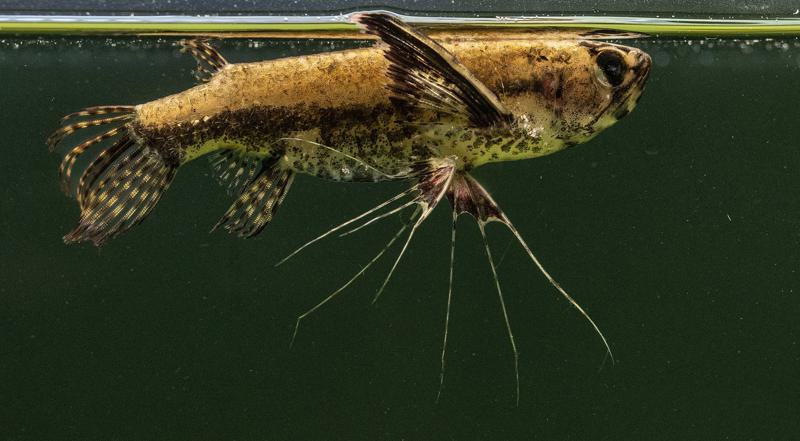
- Scientific Name: Pantodon buchholzi
- Size: 3 -5 inches
- Water Parameters: pH–0 to 8.0, Temperature–72 to 82°F
- Tank Size: Minimum of 30 gallons
- Compatible With: Peaceful fish of same-body size
Out of the wilderness of West Africa comes a unique and fascinating fish with an interesting appearance. The African Butterfly Fish features a flat top, blunt face, an array of fins looking like wings, and spiky fins.
They are a distant relative of bony-tongue fish like arowanas. These fish don’t need a lot of space and are great to keep in community tanks. They can live peacefully with large tetras and bottom dwellers like catfish and mormyridae.
While they are not efficient fish predators, avoid keeping them with small fish that can easily fall prey. Also, don’t keep them in the same tank with fish nippers like Tiger Barbs, since they will attack the long fins of African Butterfly Fish.
These fish are generally peaceful, but can be aggressive to fish of their kind. Keep a single butterflyfish or a small group in a well-panted tank.
As a nocturnal fish, they are best observed at night when they are most active.
11. Clown Killifish
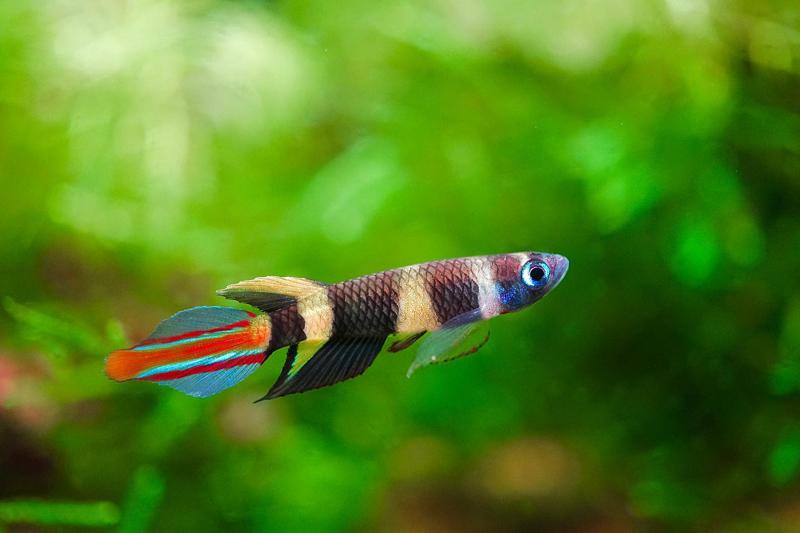
- Scientific Name: Epiplatys annulatus
- Size: 1 -2 inches
- Water Parameters: pH–7.0 to 8.0, Temperature–72 to 82°F
- Tank Size: Minimum of 10 gallons
- Compatible With: Peaceful fish of similar body size
Aquarists looking for the perfect surface dwellers to bring their aquarium to life will love the Clown Killifish.
These are small, active, and brightly colored nano fish that spend most of their time near the water’s surface. With a rocket-like body, these fish can propel themselves out of the tank. Therefore, you need a tight-fitting lid to prevent their escape.
Because they are a schooling fish species, we recommend you keep them in groups of 6 or 8. They require habitats with plenty of floating plants to facilitate breeding and hiding. Also, you must clean and maintain the tank regularly, as they are sensitive to poor water quality.
Conclusion
As you can see, each fish species offers something unique. The Betta Fish and Blue Gouramis will brighten your aquarium. Common Danios, Silver Hatchetfish, and Clown Killifish will bring your tank to life by adding movement.
Remember, most surface dwellers are excellent jumpers. Even those fish that do not jump might propel themselves out of the tank when frightened by sudden movement or loud noises. So, ensure you place a close-fitting lid on your tank to prevent them from escaping.
That’s all for today! If you have any queries or suggestions, leave us a comment below.
